This comprehensive travel guide to Hangzhou provides you with essential information about the climate, must-see attractions, and exciting activities, guaranteeing a flawless trip to China. By following this guide, you will be well-prepared for an extraordinary and unforgettable journey!
General Information
Situated in the eastern region of China, Hangzhou serves as the capital of Zhejiang Province. Renowned for its picturesque landscapes, particularly the enchanting West Lake, this city showcases the essence of Chinese traditional gardens with its distinctive sculptures and architectural features. As one of China’s premier tourist destinations, Hangzhou attracts over 20,000 domestic and international visitors each year. Once a significant hub for maritime trade during the imperial era, this city has a rich history. Hangzhou is renowned for its two Chinese specialties: tea and silk, that attract a large number of domestic and international tourists every year.
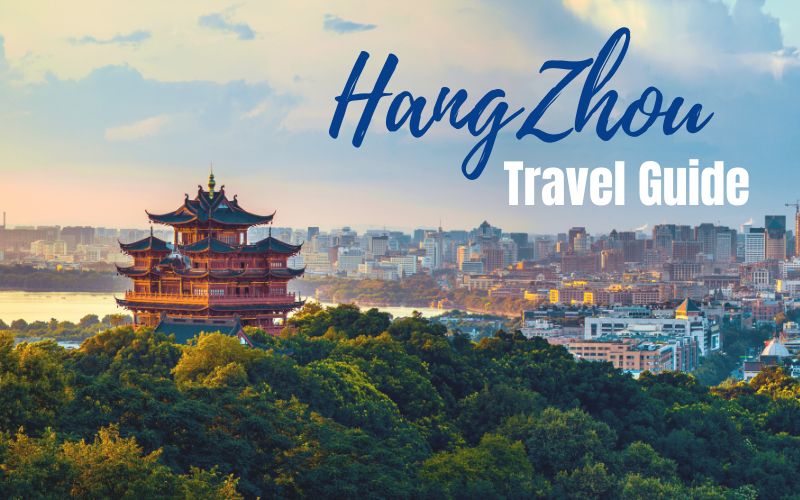
Hangzhou travel guide
Climate & Best Time to Visit Hangzhou
Hangzhou, positioned within a temperate climate zone, is typically influenced by typhoons during two periods: late June to early July and August to September. Hangzhou typically experiences a moderate and humid climate, characterized by four distinct seasons.
- Spring (From March to May): Spring in Hangzhou is mild and gradually becomes warmer. The temperatures range from around 10°C (50°F) to 20°C (68°F). It is a beautiful time to visit as the cherry blossoms and other flowers are in bloom.
- Summer (From June to August): Hangzhou experiences hot and humid summers. The temperatures can range from 25°C (77°F) to 35°C (95°F), with occasional rain showers and thunderstorms. It is advisable to carry an umbrella or raincoat during this season.
- Autumn (From September to November): Autumn in Hangzhou is pleasant with mild temperatures ranging from 15°C (59°F) to 25°C (77°F). The weather is generally clear, and the city is adorned with vibrant autumn foliage.
- Winter (From December to February): Hangzhou has cool and occasionally chilly winters. The temperatures range from 5°C (41°F) to 10°C (50°F). While snowfall is rare, it can occasionally occur. It is advisable to bring warm clothing during this season.
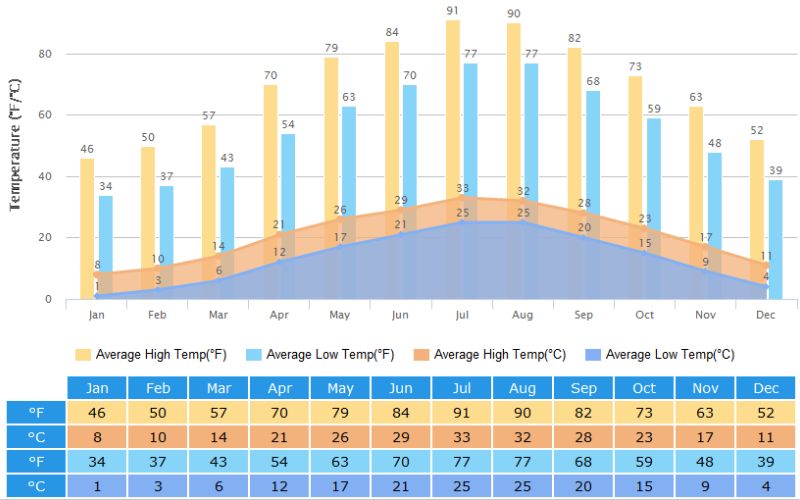
The climate of Hangzhou
The optimal time to visit Hangzhou is during the spring (March to May) and autumn (September to November) seasons. These periods offer pleasant weather with mild temperatures, making it ideal for exploring the city’s beautiful landscapes and attractions. Spring showcases blooming flowers, including the famous cherry blossoms, while autumn presents colorful foliage. It is advisable to avoid the hot and humid summer months and the chilly winter season for a more enjoyable visit to Hangzhou.
Getting to Hangzhou
By plane
Hangzhou is served by Hangzhou Xiaoshan International Airport (HGH), which is the nearest airport to the city. The airport offers a wide range of domestic and international flights, connecting Hangzhou to major destinations around the globe. Upon arrival, you have the option to take a taxi or utilize public transportation to reach your desired location within Hangzhou.
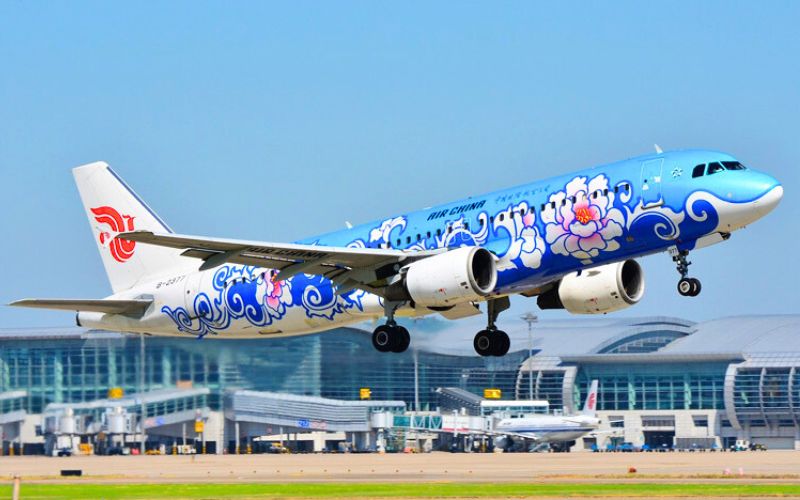
Hangzhou Xiaoshan International Airport
By train
Hangzhou enjoys excellent connectivity to China’s vast railway network, with the Hangzhou Railway Station and East Railway Station serving as the primary train stations in the city. Travelers can benefit from the convenience and speed of high-speed trains, which offer efficient connections to Hangzhou from major cities such as Shanghai, Beijing, Guangzhou, and many more.
By bus
Hangzhou boasts a well-developed long-distance bus network that links it to nearby cities and provinces. Bus stations are conveniently located throughout the city, with notable ones including the Hangzhou Passenger Transport Center and the Hangzhou East Bus Station. These stations serve as vital hubs for convenient travel within the region.
By car
For those who prefer traveling by car, Hangzhou can be easily reached by utilizing major highways and expressways. The G60 Shanghai-Hangzhou-Ningbo Expressway and G25 Changchun-Shenzhen Expressway are popular routes that provide convenient access to the city. These well-established roadways ensure a smooth and direct journey to Hangzhou.
Getting around Hangzhou
Metro
Hangzhou has an extensive and well-established metro system that effectively serves key areas of the city. The metro lines provide seamless connections to popular tourist attractions, commercial districts, and residential neighborhoods. This reliable and cost-effective transportation option offers convenience and accessibility for traveling within Hangzhou.
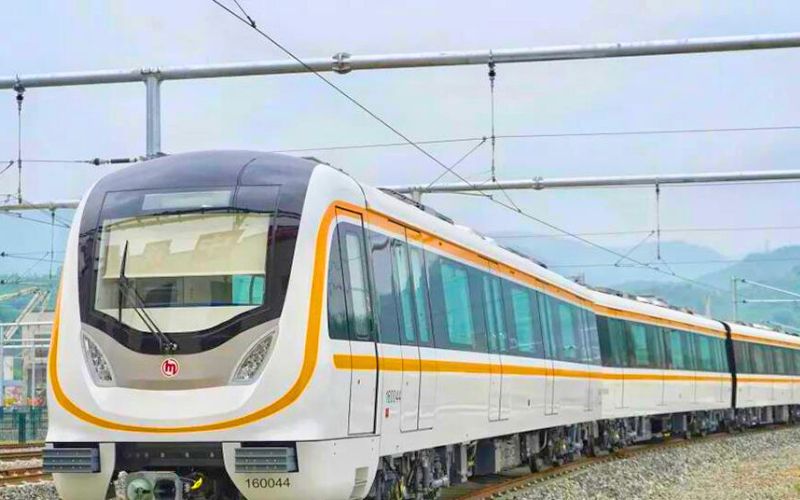
Hangzhou metro
Bus
Hangzhou benefits from a comprehensive bus network that spans the entire city, making buses a favored mode of transportation among residents and visitors alike. With affordable fares and access to various destinations, buses provide a convenient way to get around. To navigate the bus system effectively, it is recommended to have a route map on hand or utilize mobile apps that offer reliable bus information.
Taxi
In Hangzhou, taxis are readily accessible and serve as a convenient mode of transportation for navigating the city. Taxis operate on a metered system, ensuring fair fares for passengers. To facilitate communication with the driver, it is advisable to have the destination written in Chinese or utilize a translation app for smooth interaction during the ride.
Bicycle
Hangzhou has earned a reputation for being a city that embraces cycling. Its bike-friendly environment is evident through the presence of public bicycle-sharing systems scattered across the city, enabling visitors to effortlessly rent bikes for short journeys. With dedicated bike lanes on numerous streets, cycling has become a favored and pleasurable method for discovering the charm of Hangzhou.
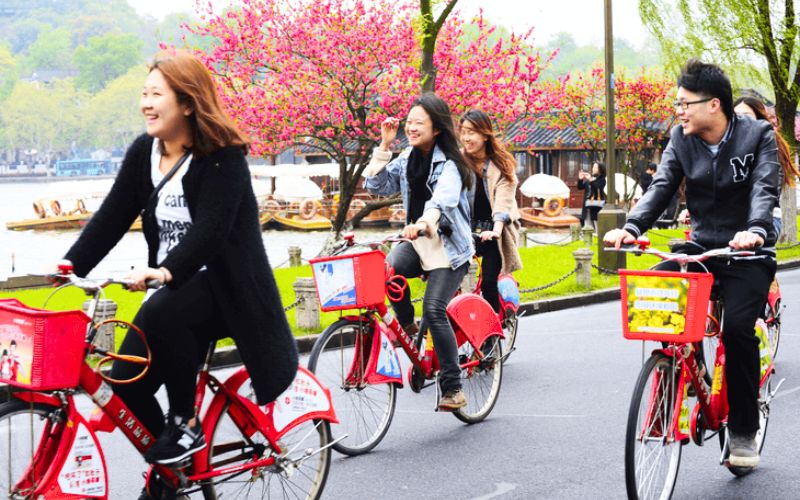
Hangzhou public bicycle
Walking
Hangzhou is renowned for its stunning landscapes, particularly around the picturesque West Lake and the historical districts. Walking leisurely is an excellent approach to immersing oneself in the city’s allure, allowing for the exploration of narrow alleys and discovering hidden gems tucked away in corners. It’s a delightful way to experience Hangzhou’s charm firsthand.
Accommodation in Hangzhou
The cost of accommodation in Hangzhou can vary depending on factors such as the location, type of accommodation, and the amenities provided. Generally, Hangzhou offers a range of options to suit different budgets and preferences.
In popular tourist areas or upscale hotels, the prices for a standard room can start from around $80 to $150 per night. Luxury hotels or high-end resorts may have higher rates, ranging from $200 to $500 or more per night.
If you are looking for more budget-friendly options, there are also mid-range and budget hotels available. The prices for these accommodations can range from $40 to $80 per night, depending on the location and facilities. In addition, Hangzhou has guesthouses, hostels, and homestays that offer more affordable options, with prices starting from $20 to $50 per night.
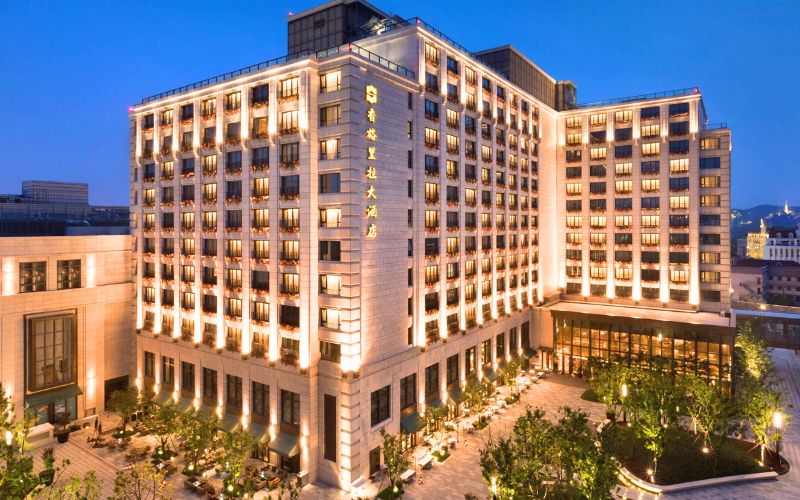
Hotel Midtown Shangri-La Hangzhou
Best Places to Visit in Hangzhou
West Lake
West Lake is an absolute must-visit destination in the enchanting city of Hangzhou. Serving as the emblematic symbol of the city and recognized as a UNESCO World Heritage site, this captivating lake boasts serene scenery, magnificent historical and cultural architecture, and breathtaking shrines, pagodas, and temples. The presence of charming arched bridges traversing verdant gardens adds to the tranquil ambiance of this place. Throughout generations, West Lake has inspired countless Chinese poets and painters to create masterpieces celebrating its allure. Visitors have the pleasure of experiencing the charm of this lake through leisurely walks, cycling, or delightful cruises.
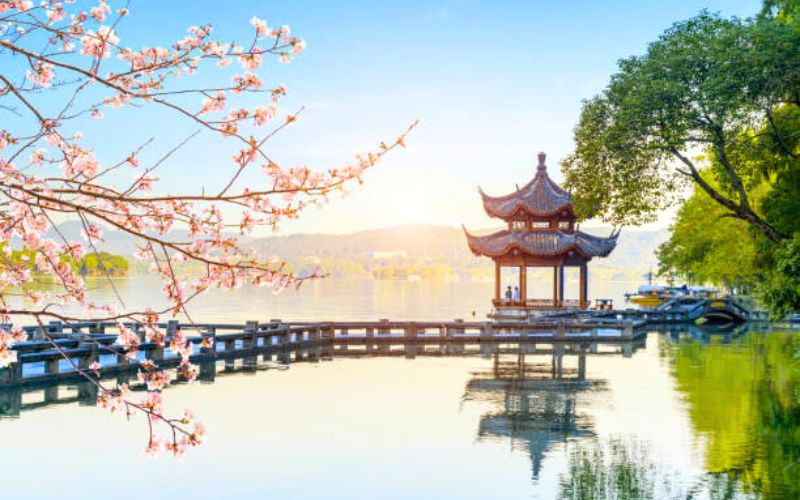
West Lake
Lingyin Temple
Renowned as one of China’s top ten iconic pagodas, Lingyin Temple, also known as the Temple of Soul’s Retreat, holds a significant place in history. Constructed in 328 AD by the Indian monk Huili, this temple is nestled amidst serene hills, exuding a tranquil and serene atmosphere. Its allure lies in its rich collection of historical structures and artistic treasures, including grottoes, pagodas, statues, and Buddhist sculptures. Lingyin Temple offers a captivating experience, allowing visitors to immerse themselves in the beauty of its ancient architecture and remarkable artworks.
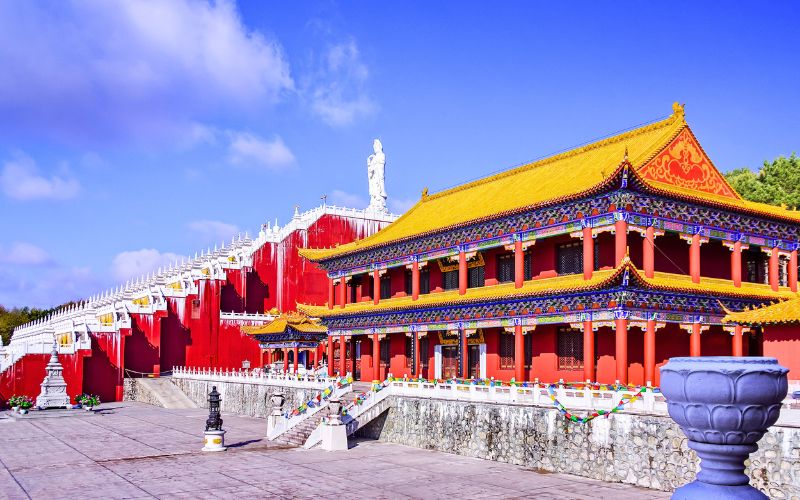
Lingyin Temple
Six Harmonies Pagoda
The Six Harmonies Pagoda, situated on the scenic banks of the Qiantang River, is a remarkable testament to architectural excellence spanning over a thousand years. Its towering presence provides visitors with breathtaking views of Hangzhou’s enchanting surroundings, inviting them to immerse themselves in the harmonious blend of history and natural beauty.
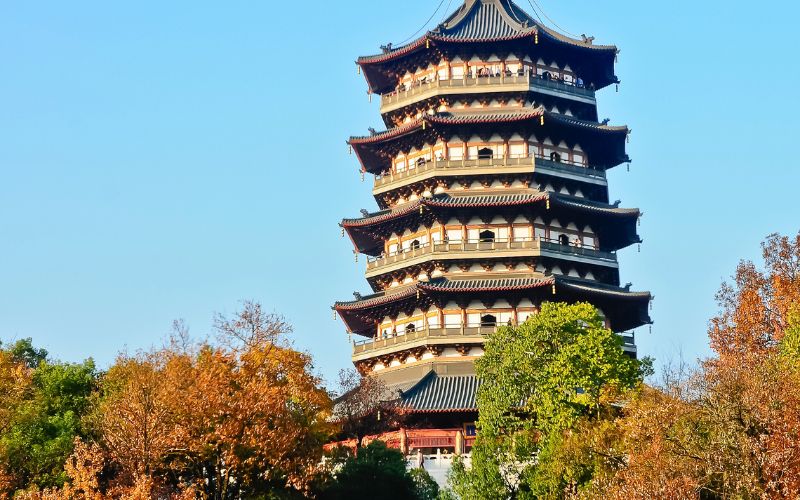
Six Harmonies Pagoda in Hangzhou
Hefang Street
Nestled in the vibrant heart of Hangzhou’s historic district, Hefang Street beckons with its lively atmosphere and captivating charm. This bustling pedestrian street is adorned with a delightful array of traditional shops, inviting teahouses, and tantalizing snack stalls. A visit to Hefang Street offers an immersive experience of the local culture, where you can indulge in mouthwatering traditional street food delicacies and browse through an eclectic assortment of souvenirs, ensuring a memorable and enriching adventure.
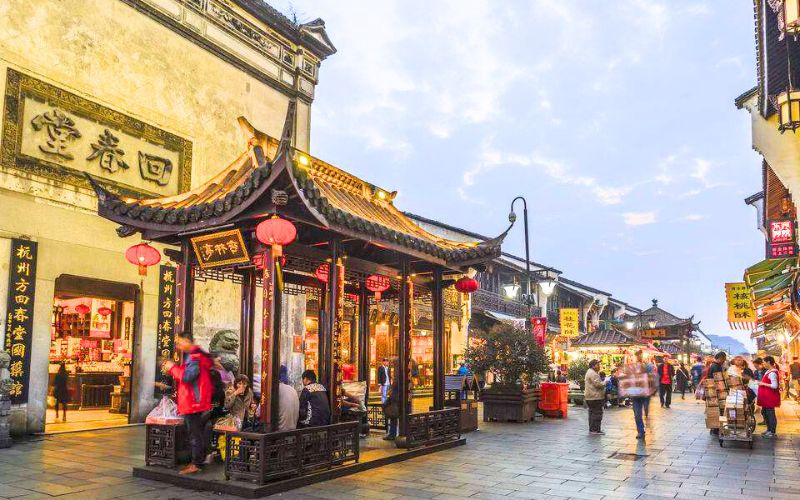
Hefang Street
Wuzhen Ancient Village
Situated 80 kilometers from downtown Hangzhou, this thousand-year-old village holds a special place as one of the most charming ancient settlements along the southern bank of the Yangtze River. With its distinctive architectural style featuring white walls juxtaposed with black or grey bricks, the town exudes an enchanting elegance akin to an ancient Chinese painting come to life. Exploring Wuzhen at a leisurely pace, floating along its canals on a traditional gondola, allows for a truly relaxing and immersive experience. On the eastern side of the village, you can delight in a variety of folk performances, including shadow plays, martial arts demonstrations, and traditional Huagu Opera.
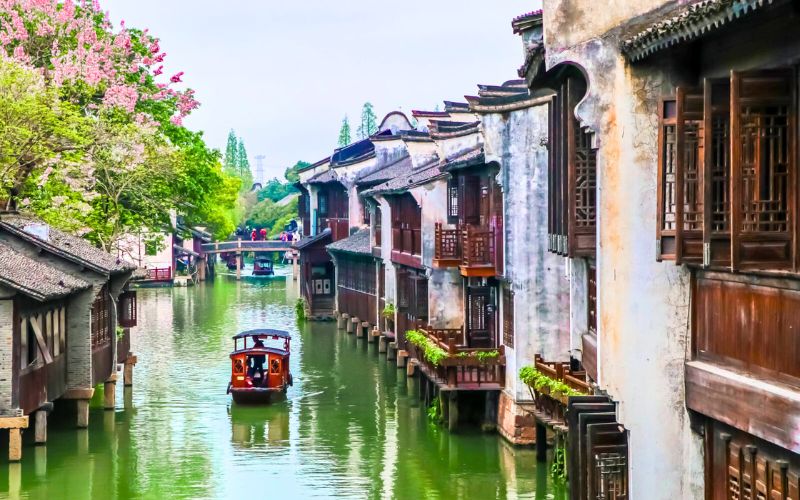
Wuzhen Ancient Village
Nanxun Water Town
Located 100 kilometers from Hangzhou, Nanxun Water Town may not be as widely known as Wuzhen, but it holds its own unique charm. Established during the Ming Dynasty, Nanxun served as a prominent silk trading hub in ancient China. Influenced by interactions with foreign merchants, the town’s architecture showcases a fascinating blend of traditional Chinese and Western styles. While the exteriors of the buildings adhere to Chinese architectural standards, you’ll discover Western influences in the intricate stone, brickwork, and carvings adorning the interiors.
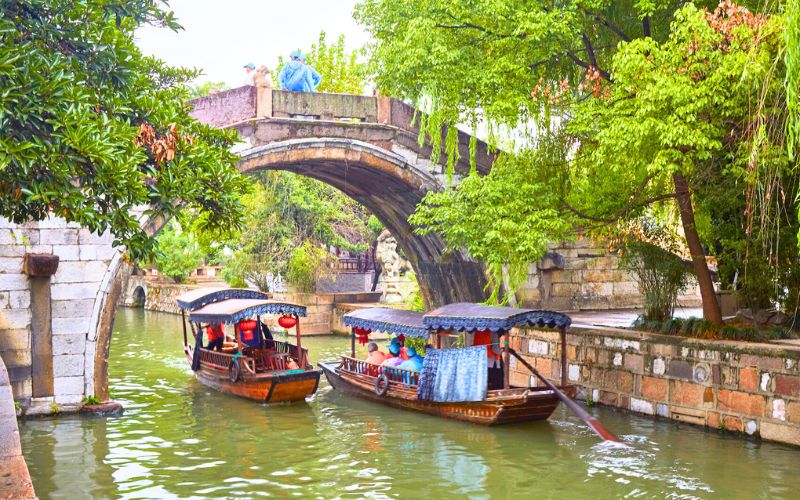
Nanxun Water Town
Exploring Nanxun offers a glimpse into the vibrant Chinese culture through noteworthy attractions such as Xiaolianzhuang (Lotus Garden), Red House (Liu’s Family Compound), and captivating wedding performances. Xiaolianzhuang is also renowned for its exquisite Chinese brush-making craftsmanship, while Red House provides an opportunity to learn about Chinese block printing techniques.
China National Silk Museum
As the largest silk museum globally, this remarkable establishment offers invaluable insights into the history and evolution of silk culture, which played a pivotal role in Hangzhou’s prosperity during the imperial era. China’s silk fabrics have long been renowned worldwide for their exceptional quality, owing to the meticulous filature and weaving techniques employed in their production. Within the museum, visitors can also marvel at historical artifacts related to the Silk Road, the renowned ancient trading route that held immense significance in connecting civilizations and facilitating exchange between diverse cultures.
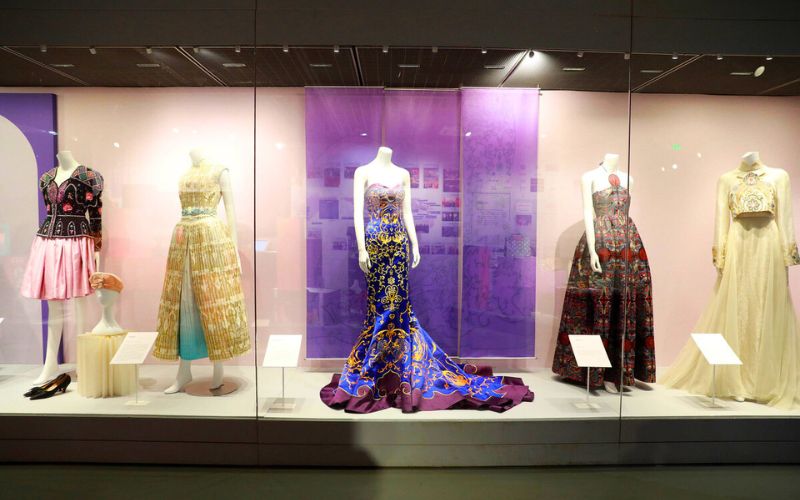
China National Silk Museum
Hangzhou National Tea Museum
With a rich history, tea holds a revered status as a national treasure in China. Chinese tea is renowned for its distinctive aroma and exquisite flavor, known to offer beneficial properties for the digestive system. Nestled amidst verdant tea plantations, the Hangzhou National Tea Museum provides a captivating setting to observe the art of tea cultivation. This museum offers a comprehensive exploration of tea’s historical significance, the intricate production processes involved, and intriguing insights into regional variations of tea etiquette across China.
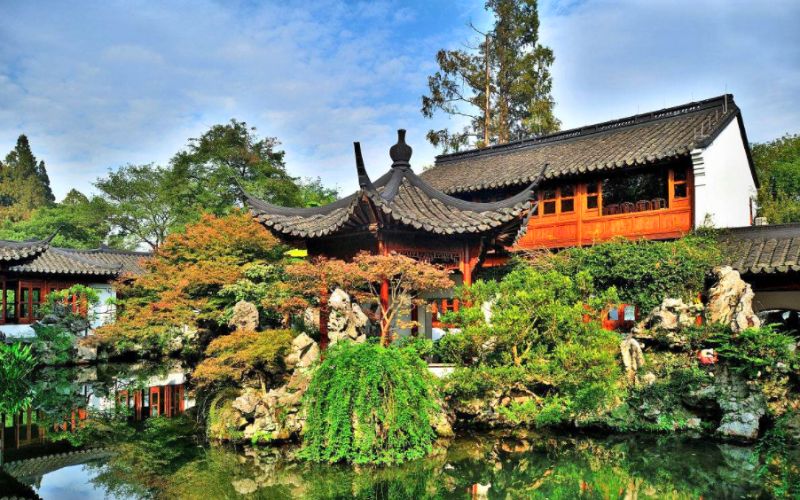
Hangzhou National Tea Museum
Meijiawu Tea Village
Renowned for its cultivation of Longjing tea, also known as Dragon Well tea, this charming 600-year-old village beckons tea enthusiasts to visit. The ideal time to explore Meijiawu Tea Village is during the spring season when engaging in exciting activities awaits, such as participating in tea leaf picking and witnessing the production of fresh tea. With over 160 tea houses dotting the landscape, visitors can relish a leisurely experience while immersing themselves in the captivating rituals of tea etiquette within this picturesque tea village. Meijiawu Tea Village is also celebrated for its delectable tea-infused culinary delights, including Longjing tea shrimp and chicken cooked with the essence of Longjing tea.
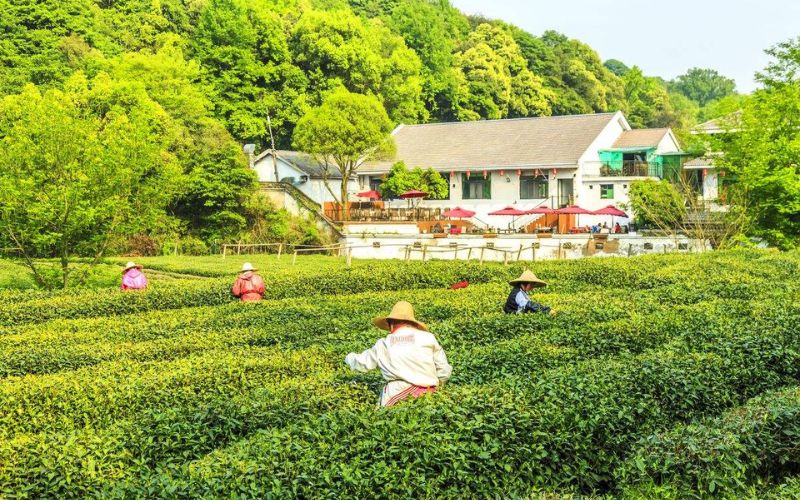
Meijiawu Tea Village
Must-try Activities in Hangzhou
Explore classic gardens and water towns
- West Lake: Offering tranquil scenery, magnificent historical and cultural architecture, and breathtaking shrines, pagodas, and temples, West Lake is an irresistible attraction.
- Wuzhen Ancient Village: Situated 80 kilometers from Hangzhou’s center, Wuzhen Ancient Village is a thousand-year-old gem nestled along the southern bank of the Yangtze River, captivating visitors with its undeniable charm.
- Nanxun Water Town: Established during the Ming Dynasty, Nanxun was once a thriving silk trading hub in China. Influenced by foreign merchants, the town showcases a captivating blend of traditional Chinese and Western architectural styles.
- Xitang Water Town: Enveloped in a serene ambiance, Xitang Water Town beckons visitors with its ancient buildings, arched bridges, and the warm hospitality of the locals, offering a perfect opportunity to unwind and appreciate classic Chinese architecture.
Explore the ancient silk and tea culture of Hangzhou
Silk and tea are the renowned specialties of Hangzhou, cherished to such an extent that dedicated museums have been established to showcase their significance.
- China National Silk Museum: Step into this museum to delve into the rich history and evolution of silk culture, which played a pivotal role in Hangzhou’s prosperity during the imperial era.
- Hangzhou National Tea Museum: Immerse yourself in the captivating world of tea at the Hangzhou National Tea Museum. Gain a comprehensive understanding of tea’s history, production processes, and fascinating variations in tea etiquette across different regions of China.
- Meijiawu Tea Village: Embark on an enchanting journey to Meijiawu Tea Village, where spring unveils a tapestry of vibrant activities. Engage in the exhilarating experience of hand-picking fresh green tea leaves and participating in the production of new tea, all amidst the picturesque surroundings of the village.
Indulge in Zhejiang cuisines
As the capital of Zhejiang Province, Hangzhou is renowned for being a culinary hub, representing one of China’s esteemed “Eight Regional Cuisines.” While cuisines from Chengdu and Chongqing may be known for their bold and spicy flavors, Hangzhou’s culinary delights offer a delightful contrast with their light, delicate, and fresh taste. When exploring the city’s gastronomic scene, be sure to indulge in some iconic dishes such as West Lake Fish in Vinegar Gravy, Dongpo Pork, Fried Shrimp with Long Jing Tea, and Jiaohua Chicken. These culinary delights will surely leave a lasting impression on your taste buds.
Must-try Foods in Hangzhou
Recognized as one of China’s illustrious “Eight Regional Cuisines,” Zhejiang cuisine encompasses various branches, with Hangzhou cuisine being the most refined and esteemed. Perfect for international tourists seeking a milder alternative to the strong and spicy flavors of Chengdu and Chongqing, Hangzhou’s culinary offerings will captivate your palate with their delicate, tender, and fresh taste. Renowned for its abundant use of fish and seafood, Hangzhou cuisine showcases the region’s proximity to water and its culinary mastery in preparing these ingredients to perfection.
West Lake Fish in Vinegar
Renowned as the epitome of Hangzhou cuisine, West Lake Fish in Vinegar stands out as the city’s most iconic dish. Fish dishes hold a special place in Hangzhou’s culinary repertoire, often served whole to symbolize good fortune. Beyond the bridges, tea houses, and gardens that grace the picturesque West Lake, an exquisite culinary experience awaits. Indulging in the delectable West Lake Fish in Vinegar amidst the scenic beauty of West Lake is sure to etch unforgettable memories in your mind. The dish carries a captivating tale from the Song dynasty when a man, earning his livelihood by the lake, fell ill. His sister-in-law prepared the revitalizing West Lake Fish in Vinegar, leading to his swift recovery. Symbolically, this dish reflects the bittersweet nature of life, where sweetness and sourness intertwine.
Dongpo Pork
Dongpo Pork, named after the esteemed poet Su Dongpo from ancient Hangzhou, carries a captivating tale from history. Legend has it that the local community presented pork to Su Dongpo as a gesture of gratitude for his contributions to constructing roads and bridges. In a display of generosity, Su Dongpo cooked the entire portion of pork and shared it with the people. This renowned dish features thick slices of succulent pork belly, marinated with a harmonious blend of vinegar, ginger, pepper, and sugar. Pan-fried to perfection and then slowly braised for hours, the result is a dish that exudes richness and tenderness.
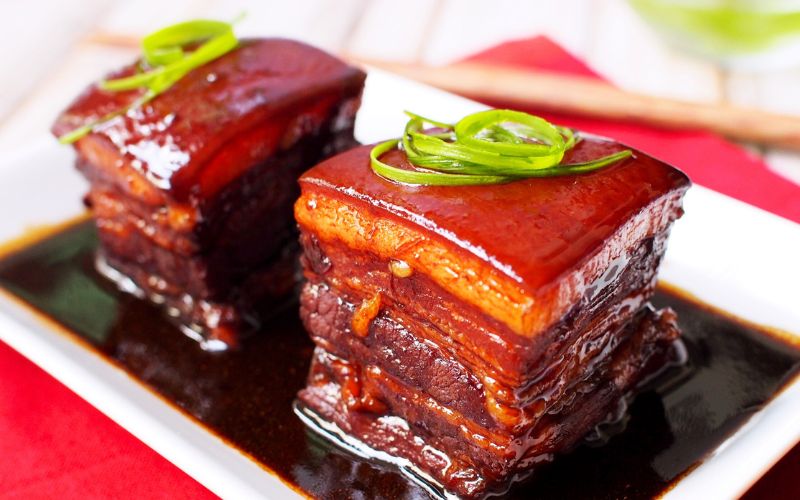
Dongpo Pork
Fried Shrimps with Long Jing Tea (Dragon Well tea)
When exploring the enchanting tea villages of Hangzhou, indulging in Fried shrimp with Long Jing Tea is an absolute must. This delectable dish showcases a meticulous preparation technique that ensures the shrimp and tea leaves are fried to perfection, avoiding any excessive oiliness or greasiness. The shrimps, delicately coated with a mixture of egg whites and starch, exhibit a captivating jade hue. Each bite reveals a tender and succulent texture, accompanied by a delightful aroma derived from the fragrant tea leaves.
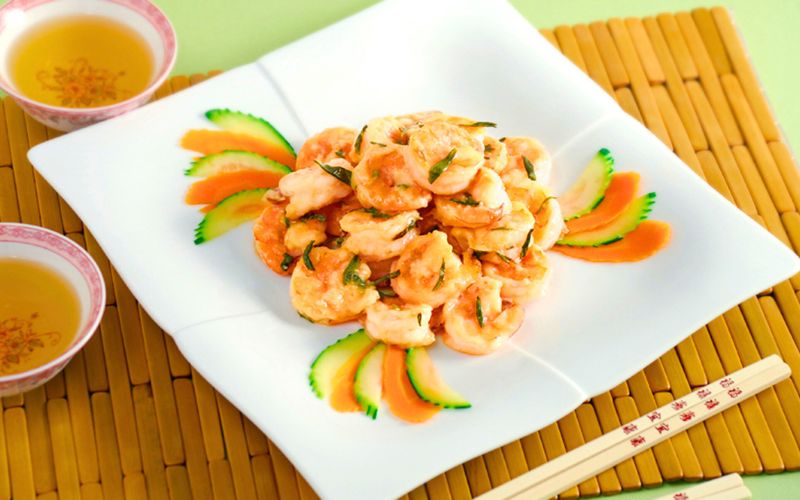
Fried Shrimp with Long Jing Tea
Jiaohua Chicken (Beggar’s Chicken)
Jiaohua Chicken, also known as Beggar’s Chicken, is a tantalizing dish that demands both patience and time. With a preparation process that typically spans 6 hours, this culinary masterpiece is well worth the wait. The chicken is carefully enveloped in layers of lotus leaves and mud, creating a sealed cocoon within a clay pot. Slowly roasted over an open fire, the clay pot remains unopened until it reaches your table, unveiling a feast for the senses. The delicate aroma of lotus leaves infuses the tender meat, while the succulent flavors encapsulate the essence of this renowned Hangzhou delicacy.
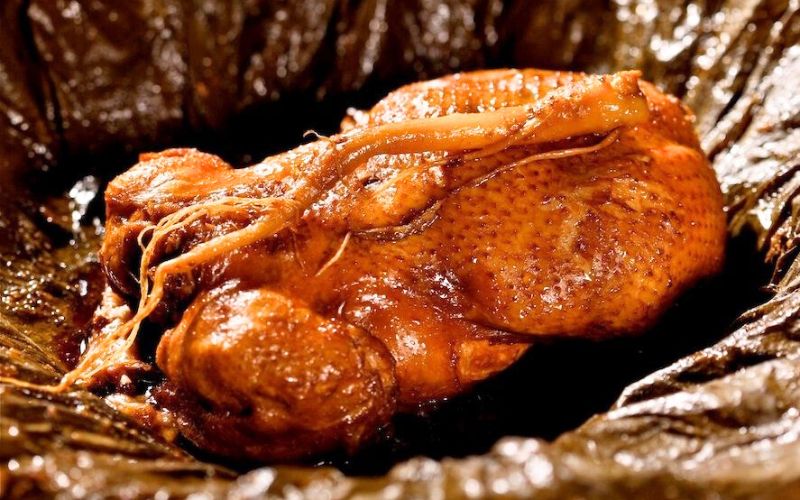
Jiaohua Chicken
With its seamless blend of tradition and modernity, Hangzhou captivates visitors with its allure. Whether you seek cultural enrichment, natural beauty, gastronomic delights, or a glimpse into China’s past, Hangzhou promises an unforgettable journey filled with captivating experiences. If you are considering a visit to Hangzhou, we are here to assist you and provide any additional information you may need. Contact us for any inquiries to ensure that your trip to Hangzhou is truly memorable.
